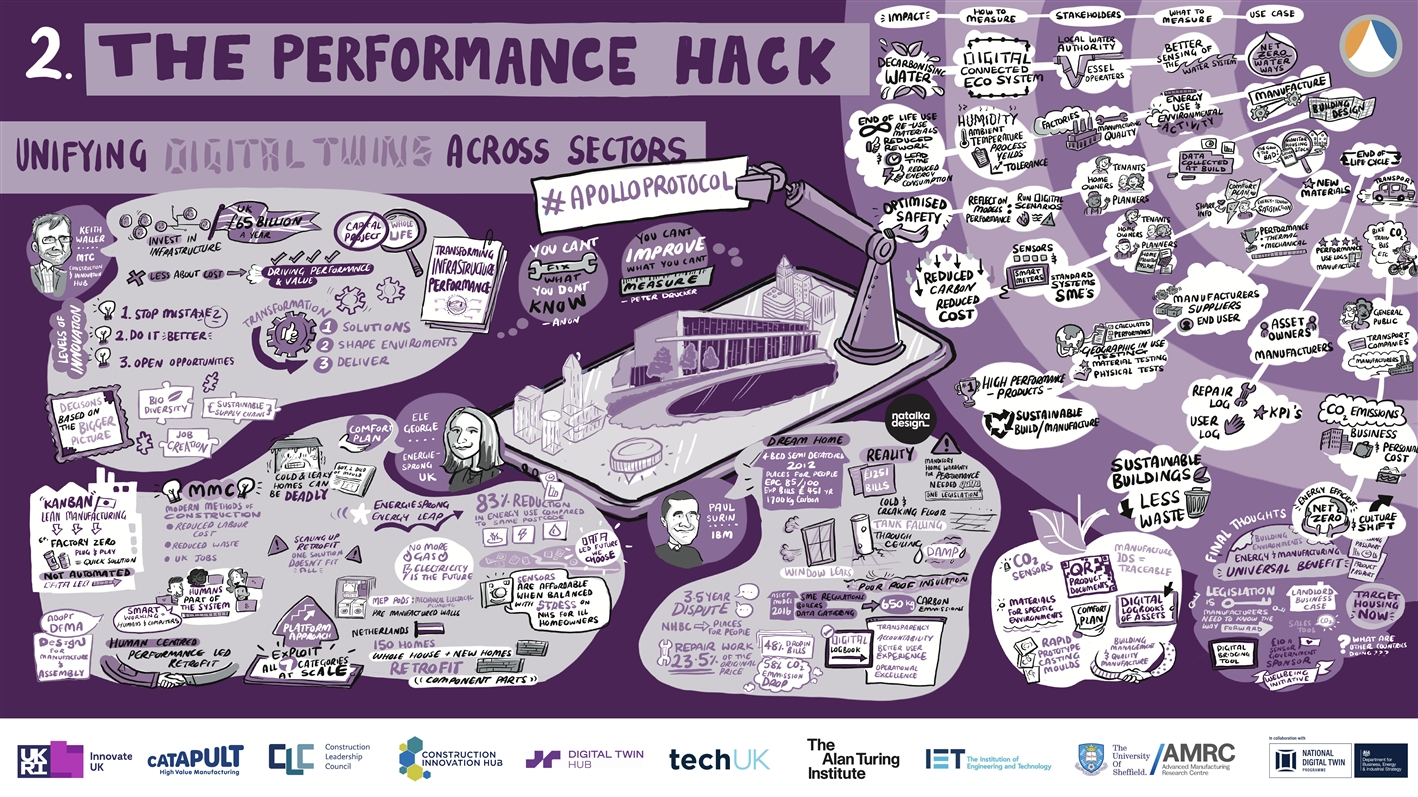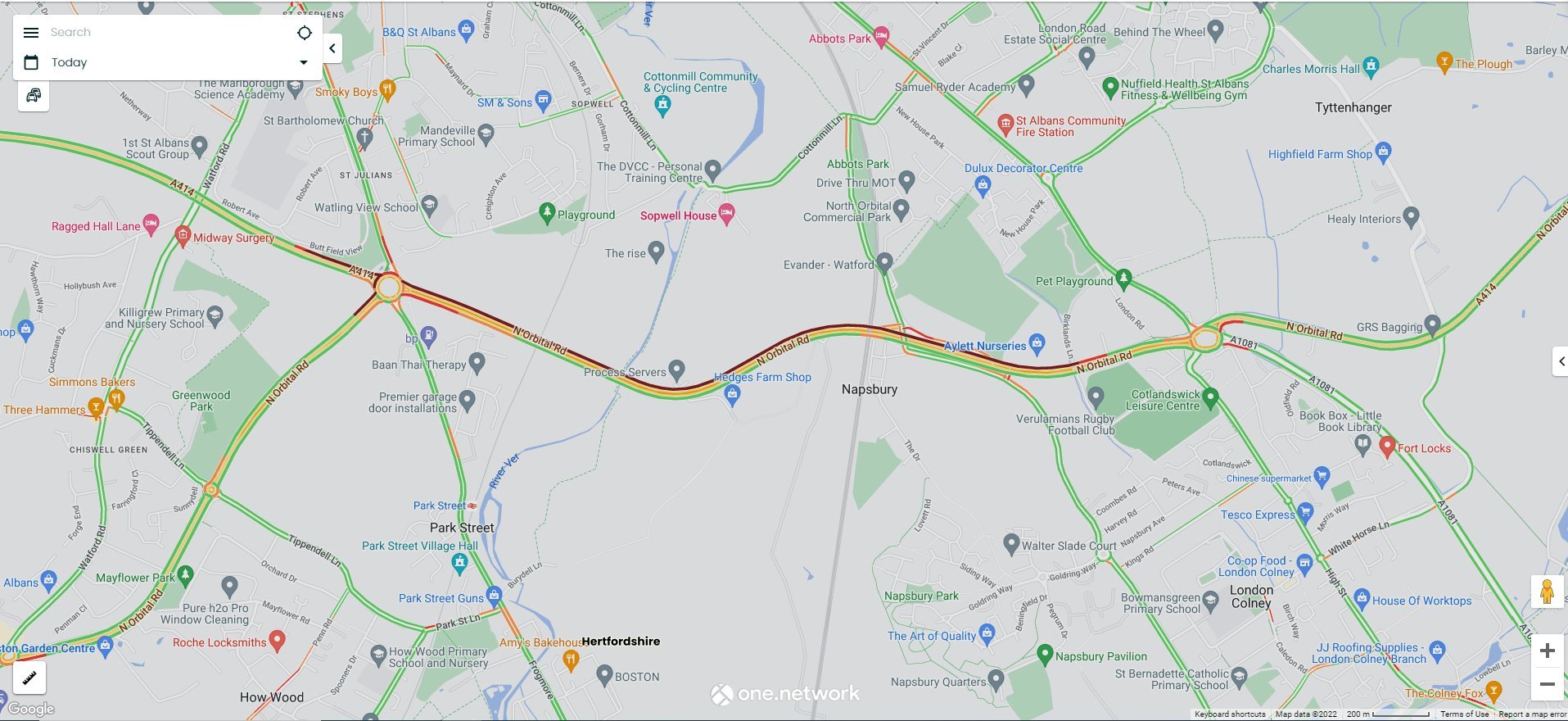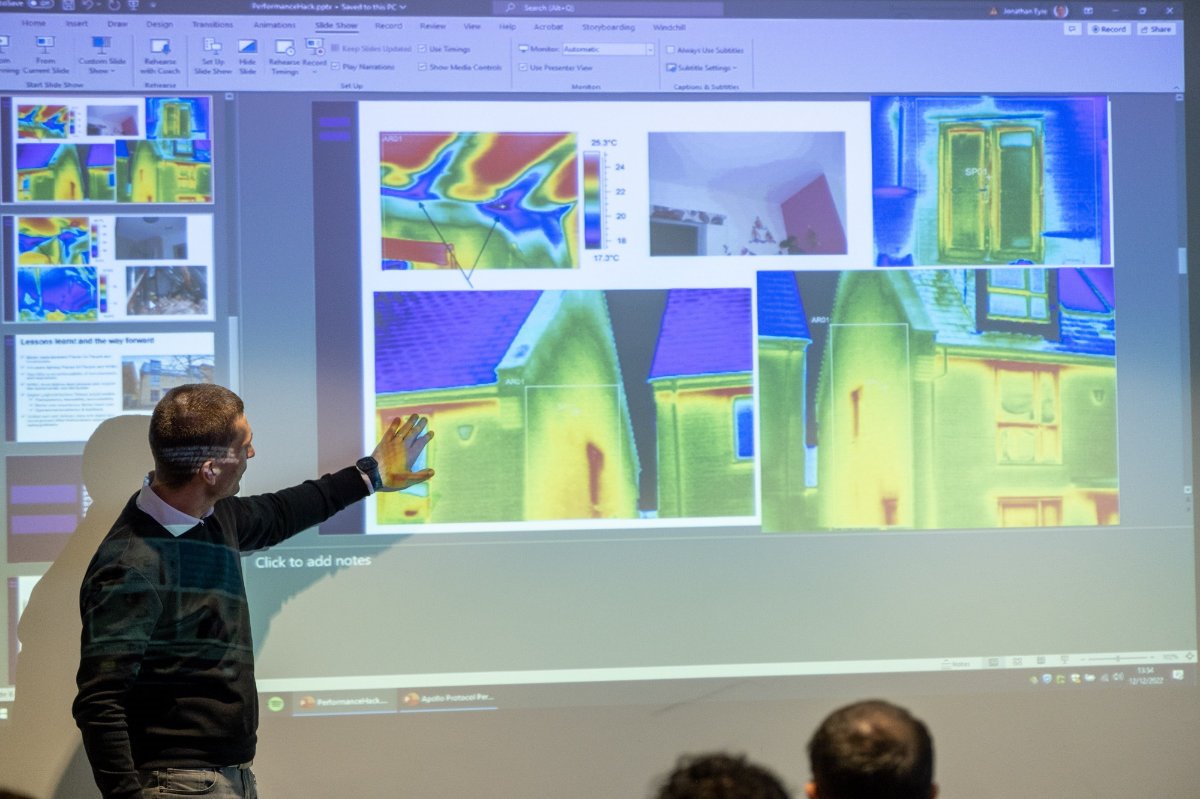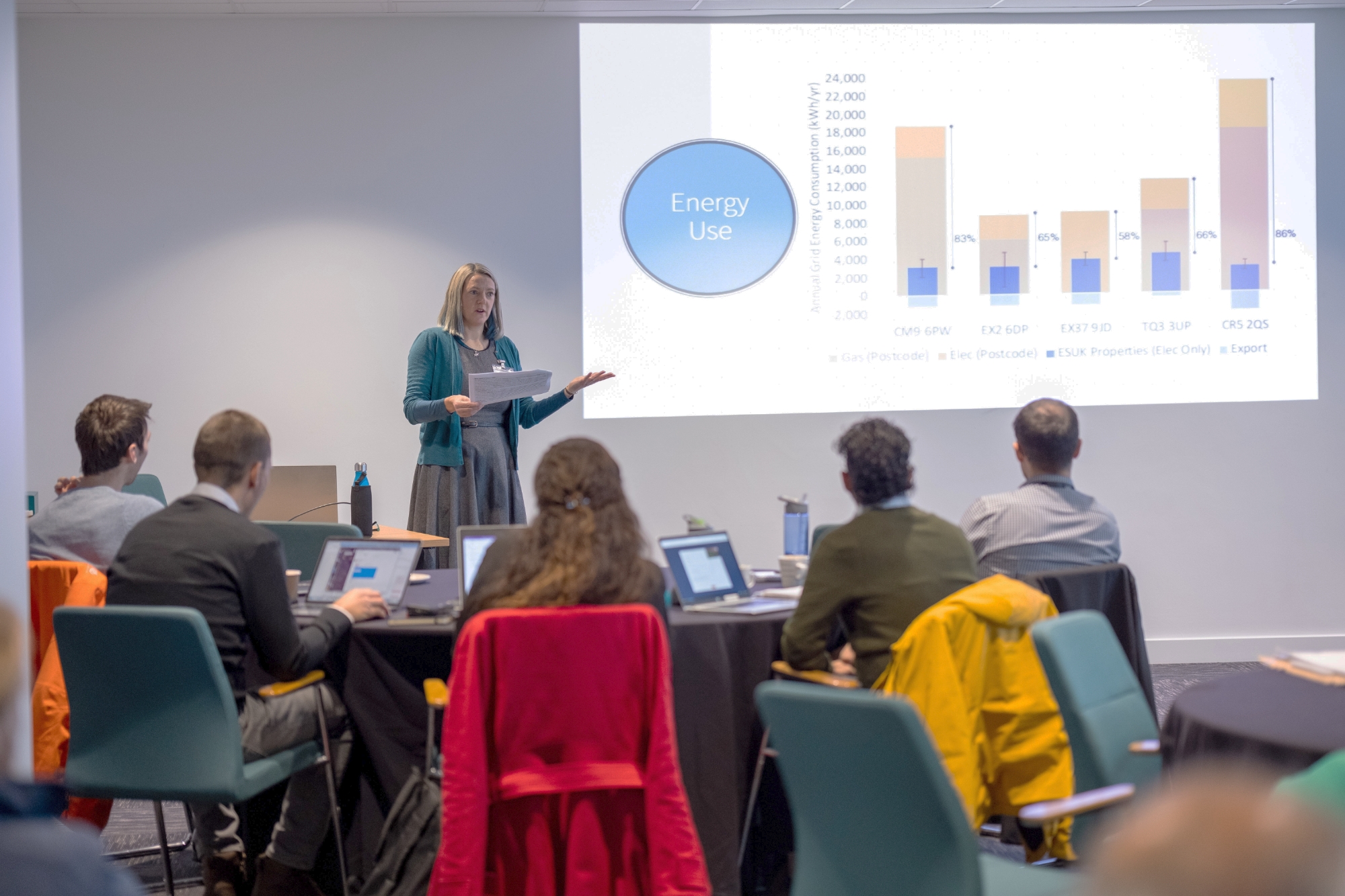Here’s a summary of some of the outcomes of our second Apollo Protocol Hack and information about how you can join the next one.

As we gathered at the AMTC for the in-person hack day, it was perhaps ironic that a digital twin helped us get there. Snow had caused major disruption overnight, and without the near real-time evidence provided by Google Maps’ live traffic feature, many of our delegates would not have had the confidence to set out to join us. As it turned out, we still had healthy numbers, further boosted by attendance at the online hack three days later.

Google Maps’ live traffic feature is a digital twin. Source: Hertfordshire Highways 12 December 2022
The Performance Theme
Performance is evaluating whether what we intended to happen, is happening.
This theme is so important to the effectiveness of our work in both manufacturing and the built environment. Manufacturers rarely know how their products perform in the field, yet the ‘performance gap’ between design intent and actual outcomes is one of the biggest challenges facing the built environment. We have much to learn.

Extract from ‘The Apollo Protocol: unifying digital twins across sectors’ White Paper
Why Performance Matters
The built environment lacks accountability for failed performance. This was brilliantly illustrated by Paul Surin’s presentation about the ‘dream house’ he bought in 2010, which turned out to be a lesson in how difficult it is to get what you pay for.

Thermal images from Paul Surin’s house, a ‘state of the art’ eco home which required major repairs.
By exploring the reasons for systemic failure we can better understand why, and ultimately, bring about change. This isn’t only about the information, or the engineering required, but also about the human interfaces. For example, traditional procurement methods pass risk, cost and responsibility down the supply chain to smaller and smaller contractors and installers who are squeezed into an impossible choice between whether to stay in business or do a good job. Poor construction and maintenance of residential properties doesn’t just lead to financial loss, but also has a humanitarian cost, even to the death of a child.
The lack of accountability for failures in performance could be resolved in part by data transparency. Data produces evidence, reducing or removing the motivation to rely on human factors such as speculation or prejudice. We heard in the hack session that four sensors, costing as little as £10 each, could confirm a building is healthy or warn of problems. What would be the required motivation to make this happen? What would prevent it?
The Government View of Performance
Government is steering industry towards a more holistic approach to performance, fuelled by innovation. To explain this change, we welcomed an address by Keith Waller, programme director at the Construction Innovation Hub.

Keith Waller outlines Government infrastructure strategy
The UK invests £65bn a year in infrastructure – schools, energy networks, transport and more. In future, major infrastructure investment decisions for these funds will be less about cost and more about driving performance and value.
Performance is to be measured across the whole life of an asset, across the network it sits in, and across the wider system (the network of networks). Metrics also need to value the wider benefits to the economy, to the environment and to society, such as local investment and employment opportunities. The key to achieving this change is to drive performance through evidence-based decisions, which means we need access to robust data. Data transparency and interoperability therefore feature prominently in the governments’ plans.
You can read more about the government strategy and how it will be implemented in Transforming Infrastructure Performance (2021), the Infrastructure and Projects Authority flagship programme to lead system change in the built environment.
What happens when you measure performance
“You can’t improve what you can’t measure” – Peter Drucker
Once you start collecting data, a wealth of options is available. Ele George of EnergieSprong UK demonstrated this with a quick tour of the retrofit company’s work in the UK, using modern methods of construction (MMC) on groups of social housing units.

Ele George showing energy savings in EnergieSprong retrofit housing
At the core of EnergieSprong UK’s work is the use of data to evaluate performance, thereby enabling a ‘performance guarantee’. You can read examples of how this is working in the reports of their top ten findings so far – Part 1 and Part 2.
The purpose of measuring performance is to LEARN from it; everyone in the supply chain learns. Previously predicted performance is confirmed, or if not, the results can inform necessary changes. Where high levels of performance are identified, the objective is to replicate these instances. Results are interrogated for their meaning, identifying opportunities for learning. This is a genuine measurement feedback loop, enabling continual improvement.
Data sharing also creates business opportunities. Solution providers (contractors) learn about what is working and improve their processes. They feed back to manufacturers who learn how to improve their products. Tenants learn about how their homes are performing, as do the housing providers. Companies and organisations promote their successes, but also promote their willingness and ability to improve where success isn’t as good as hoped.
Use Case Examples – identifying what is possible
Armed with the inspiration of our speakers, delegates at the hack sessions came together to identify performance related use cases for digital twins within and between the manufacturing and built environment sectors. By identifying and exploring potential performance related use cases, we can push forward with projects that generate proofs of concept and ultimately create change.

Delegates explored their possible use cases using an onion diagram
Our mixed groups explored, evaluated and recorded their ideas through various exercises on a Miro board, and then entered the use cases into the Value Knowledge Graph (which we introduced in the previous article).
A wide range of use cases were discussed. Here are just some examples:
- Monitoring the performance of new materials in the built environment would lead to the more successful introduction of high-performance products.
- The live mapping of transport use would lead to better strategic transport decisions and reduced CO2 emissions.
- Real-time optimisation of water treatment processes would lead to reduced energy and chemical use, enhanced operation and lower costs.
- Demand-side measurement of the use of EV charging stations could inform future prediction calculations for energy consumption and enable government to reach its strategic goals.
- Monitoring the performance of any asset in the field can enable prediction of its remaining useable life, allowing for better informed strategic planning.
- Detecting void properties in the h ousing sector using CO2 sensors would not only be low cost but through freeing up empty properties sooner, would save landlords months of rent.
- Sharing the in-use performance of homes could inform designers, manufacturers and contractors of a residents’ needs and preferences, enabling them to produce more efficient homes based on evidence, not speculation.
- Digital logbooks of any built asset can be a vehicle for evaluating in-use performance, closing the performance gap, improving air quality and user health and producing safer buildings.
The Value Knowledge Graph will be made open source, enabling collaborative groups to use the learning from our sessions to explore the connections and identify potential projects for action and investment.
Listen to the Apollo Forum Podcast
 If you’re interested to learn more about what we discussed, why not listen to the podcast episode about this hack? It includes interviews with Ele George and Paul Surin and conversations with participants (including me).
If you’re interested to learn more about what we discussed, why not listen to the podcast episode about this hack? It includes interviews with Ele George and Paul Surin and conversations with participants (including me).
Listen here:
https://soundcloud.com/apollo-forum/performance-hack-podcast
Follow the podcast so you get notifications when we publish new episodes.
Join the Apollo Forum Hacks

Our next hack will be looking at Circularity, the concept of maintaining value, extending the lifespan of products and not creating waste.
If you are interested in developing a genuine circular economy between manufacturing and the built environment, whether you’re an asset owner, manufacturer, built environment or tech professional, we’d love you to join us at these free, interactive events.
In person:
The Circularity Hack at IET Birmingham:Austin Court, 9.30-4 on 19 January
On Zoom:
The Circularity Hack Online 1-4pm 26 January
About the Apollo Protocol
The Apollo Protocol is an initiative to unlock the benefits of digital twins between the built environment and manufacturing sectors, supported by the technology sector.
Read more in our white paper The Apollo Protocol: unifying digital twins across sectors
The initiative is supported by:
- The Department for Business, Energy and Industrial Strategy (BEIS)
- Innovate UK
- The Institute of Engineering and Technology (IET),
- The Construction Leadership Council (CLC),
- The University of Sheffield Advanced Manufacturing Research Centre (AMRC),
- The High Value Manufacturing (HVM) Catapult,
- The Construction Innovation Hub,
- The Digital Twin Hub,
- techUK and
- the Alan Turing Institute.